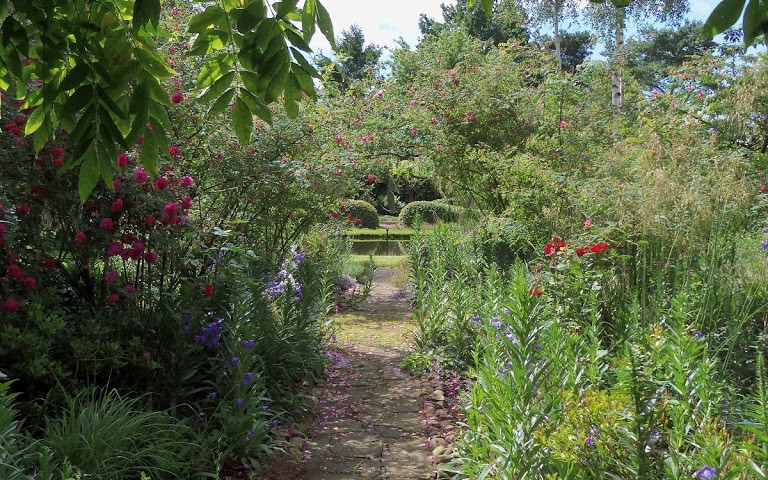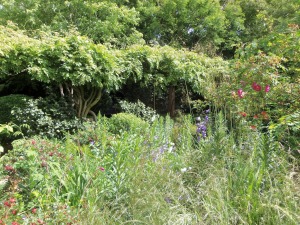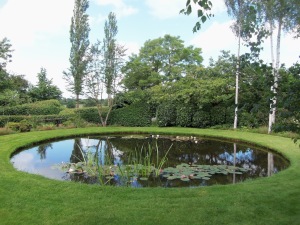Graham Cousins went house-hunting with a spade. He and his wife Jenny decided to sell their comfortable suburban house on the outskirts of Leicester because its modest garden did not afford them the scope to fulfill his childhood dream of some acreage with a view. In 1981 they drove up an unpaved and impossibly narrow drive in Walton, Leicestershire, and found a wildly overgrown acre + of land, with a little brick bungalow. Undeterred that the house was hardly large enough, Graham strode determinedly around the property, turned the dirt in several locations, and with a satisfied smile, pronounced this their new home.
Even though Graham was Director of Leicester University’s bookstore operation and there was one child still at home, the Cousins family found time to turn a forgotten refuse yard (Orchards is the property’s official name, after the grove of fruit trees along the eastern property line) into one of rural England’s treasured but hidden private gardens. In the now expanded brick cottage and in the garage (which doubled as a dining room during construction) there are fascinating series of photos documenting the stunning developments over the years. Among the family portraits is a large photo of Graham standing next to British TV personality Roy Lancaster, commemorating a peak moment in the family history, the garden’s appearance on national TV. (Ask Graham about the inquisitive cows that almost ruined the shoot.)
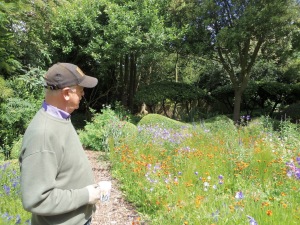 |
| Graham in his garden |
Orchards is not a sentimental garden; there is no irrigation system, and plants must survive without artificial support. In keeping with this ruggedness (which encourages native plants to flourish) Graham ripped out the trellises because he felt they were an unnatural crutch for the roses; the roses that remain have adjusted and are wilder and stronger.
Thousands of Japanese, Dutch, German, and British tourists have seen the garden. Even so, for so public a garden it is a very private place. Walton is a small village, and there is no parking for tour buses, so most visitors arrive in their own vehicles, parking across the street and walking up the now paved drive, aware that they are entering a singular and mysterious vision.
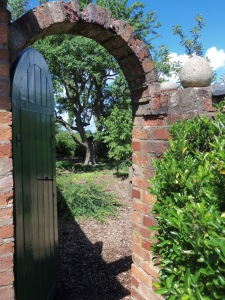 |
| The garden gate |
Let Yourself Go
From the beginning, instinct is the best guide. There is no single entrance to the garden, and there is no single route; everything is designed to encourage wandering. For example, through the weathered brick arch, the inviting overlook at the far end beckons, where there are benches and a hint of the landscape beyond. But on the way there is a large reflecting pond, and the sight of a sequestered Asian tea house that is worthy of investigation. However, a bank of unusually sensuous Ponytail grass (Stipa tenuissima) dotted with field poppies (papaver rhoeas) and rose campion (lychnis coronaria), comes into view, and the visitor’s purpose is again interrupted. By this casual and subtle system of invitation and redirection, the garden can never be experienced the same way twice.
Green, How I Love You, Green (Lorca 1899-1936)
On the left side of the garden, a grand and ancient apple tree (200 years old? older?) casts a magnificent shadow, the centerpiece of a stunning display of different shades of green; in fact, green is the only leaf color here. Graham’s affinity for the exuberance of Spain, where he traveled extensively in his youth before settling back in his native Midlands, combines with his English passion for understatement, in a subdued tribute to Federico Garcia Lorca’s favorite color. Astutely avoiding artificial leaf colors, he forces the eye to differentiate among so many ostensibly monochromatic tones; dark greens become more deeply verdant, lighter greens seem more yellow.
 |
| The end of “The Avenue” in winter |
Borrowed Views
The gravel overlook commands a view across the Leicestershire fields to the village of Gilmorton. A perceptive eye will see that the spire of All Saints Church is one anchor point of the garden’s main axis, and that the other is the bed in the master bedroom! Here Graham capitalizes on the garden’s location; the borrowed vista implies that the land is much bigger, that the cows and the fields are all part of a larger picture.
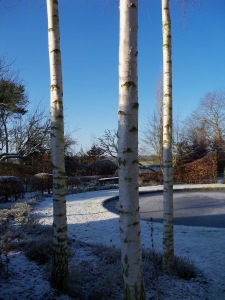 |
| The pond in winter |
Lie Back and Relax
The wildest and least explored area is the Orchard itself. Graham lets the ground cover of native meadow grasses overgrow here, to the delight of the neighborhood cats who hunt through the dense overgrowth. On a lazy summer day naptime can be spent in a hammock slung between the pear, apple and plum trees.
In Season and Out of Season
Graham believes that gardening (and garden-viewing) should be a year-round delight, and to that end the natural life-cycles of the plantings are respected and coordinated so that the garden is worth exploring throughout the year.
Rooms for the Imagination
Another borrowed view is the pool. At first glance its size feels out of scale with the rest of the garden; the expanse of water seems to dwarf the ring of grass around it. Yet it is a serene oculus that brings the sky more intensely into the garden; the clouds, birds, and tree-tops are all mirrored on the surface, accentuating the depth and height that connects the life of the garden with the life of the air and the vistas of the world beyond.
This post was co-authored with Paul Crabtree.
A future post will include an interview with Graham Cousins about his philosophy of gardening.
For more information please visit http://www.grahamsgreens.com/
